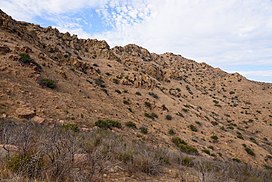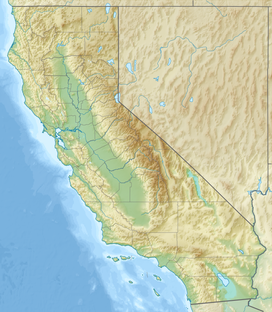Simi Hills
| Simi Hills | |
|---|---|
 Main ridge of Simi Peak, highest summit of the Simi Hills | |
| Highest point | |
| Peak | Simi Peak |
| Elevation | 2,139 ft (652 m) |
| Geography | |
location of Simi Hills in California[1] | |
| Country | United States |
| State | California |
| Districts | USGS Calabasas |
The Simi Hills are a low rocky mountain range of the Transverse Ranges in eastern Ventura County and western Los Angeles County, of southern California, United States.
Geography
This section needs additional citations for verification. (January 2021) |
The Simi Hills are aligned east-west and run for 26 miles (42 km), and average around 7 mi (11 km) north-south. The Simi Hills are part of the central
The Simi Hills are on the western edge of the
The two nearby mountain ranges are: the higher Santa Susana Mountains adjacent on the northeast across Santa Susana Pass; and the Santa Monica Mountains running nearby along the south.
Watersheds
The hills provide the complete or partial
Peaks
Peaks in this region include Simi Peak, 2,403 ft (732 m),[3] Chatsworth Peak, 2,314 ft (700 m),[4] and Escorpión Peak (aka: Castle Peak), 1,475 ft (450 m).
Climate
Because of its low elevation, the Simi Hills typically experience rainy, mild winters. Snow is rare in the Simi Hills, even in the highest areas. Summers are warm and dry and wildfires do occur here. Cool winds from the Pacific Ocean come from the Oxnard Plain and blow into the inland areas through the Santa Clara River Valley and the Conejo Valley, though some low hills, such as Conejo Mountain, block these winds from the Conejo Valley. The Simi Hills further block these winds, which bring cool weather in both summer and winter from the San Fernando Valley.
Flora and fauna
Flora
The southern lower hills are mostly covered in
Fauna
The Simi Hills is the principal, and much wider, of only two terrestrial
Large sections of the Simi Hills are protected by parks and open space preserves. The Santa Susana Field Laboratory property, a crucial wildlife corridor to the Santa Susanas, has been proposed for public open space parkland after the closed site's cleanup completion.
The population of red-legged frogs is small and isolated, and was impacted by the Woolsey Fire swept through the area in November 2018.[7]
History
The Simi Hills were inhabited for over 8,000 years by
The Juan Bautista de Anza expedition passed through the area in 1769, being the first European sighting of the Simi Hills. The U.S. National Park Service administers the Juan Bautista de Anza National Historic Trail which enters at Moore Canyon in El Escorpión Park and crosses across the southern Hills through Upper Las Virgenes Canyon Open Space Preserve and Cheeseboro/Palo Comado Canyon Park to the Conejo Valley.[13] In 1845 the land grant for Rancho El Escorpión, beside the Peak and named for it, was issued to one Chumash and two Tongva people and a rare instance of Native Americans being grantees, by Mexican Governor Pío Pico. The Rancho El Conejo was to the west, and included that end of the Simi Hills.[citation needed]
In the first half of the 20th century, there were four large
The Simi Hills were home of the
The
Parks
- Bell Canyon Park with Bell Creek; West Hills and Bell Canyon[21]
- Challenger Park
- Cheeseboro/Palo Comado Canyon Park - in the Santa Monica Mountains National Recreation Area, western Simi Hills in Ventura County.[22][23][24]
- El Escorpión Park and the Moore's Canyon Juan Bautista de Anza National Historic Trail segment; West Hills, Los Angeles[25][26]
- Rocky Peak Park - adjacent and above Santa Susana Pass[27]
- Ronald Reagan Presidential Library complex with museum
- Sage Ranch Park - near the Santa Susana Field Laboratory with trails and camping.[28][29][30]
- Santa Susana Pass State Historic Park - with the Old Santa Susana Stage Road in the rocky northern Simi Hills.[31][32]
- Upper Las Virgenes Canyon Open Space Preserve - (previously the Ahmanson Ranch Park), 3,000 acres (12 km²) Park in the southern Simi Hills, managed by the Santa Monica Mountains Conservancy.[33]
Nearby ranges
See also
- Burro Flats Painted Cave
- Bell Creek
- Rancho El Escorpión
References
- ^ "Simi Hills". Geographic Names Information System. United States Geological Survey, United States Department of the Interior. Retrieved 2009-05-03.
- S2CID 129607293.
- ^ "Simi Peak". Geographic Names Information System. United States Geological Survey, United States Department of the Interior. Retrieved 2009-05-03.
- ^ "Chatsworth Peak". Geographic Names Information System. United States Geological Survey, United States Department of the Interior. Retrieved 2009-05-03.
- The Associated Press. Retrieved 21 June 2018.
- ^ Roth, Annie (June 21, 2018). "Den of Mountain Lion Kittens Found in Unlikely Place". National Geographic. Archived from the original on June 22, 2018. Retrieved 21 June 2018.
- ^
 This article incorporates public domain material from California Red-Legged Frogs: Santa Monica Mountains National Recreation Area. National Park Service. Retrieved 2021-07-12.
This article incorporates public domain material from California Red-Legged Frogs: Santa Monica Mountains National Recreation Area. National Park Service. Retrieved 2021-07-12.
- ^ USA Today article USA Today Accessed 2/22/2008
- ^ "Mercury News article". mercurynews.com. Retrieved 9 April 2018.
- ^ "Archived copy" (PDF). Archived from the original (PDF) on 2010-03-14. Retrieved 2010-03-23.
{{cite web}}: CS1 maint: archived copy as title (link) SSPSHP Ethnohistory Accessed 2/28/2010 - ^ ""Wishtoyo - Projects - Cultural - Ahmanson Ranch". Archived from the original on 2009-03-13. Retrieved 2010-03-24. Ahmanson Ranch Becomes Private Preserve," [Wishtoyo Foundation website. Accessed 10/23/2007
- ^ Wishtoyo on Ahmanson Ranch accessed 10-23-2007 Archived 2009-03-13 at the Wayback Machine
- ^ http://www.nps.gov/juba/ National Park Service: official Juan Bautista de Anza National Historic Trail website. accessed 4/06/2010
- ^ http://www.dtsc-ssfl.com/default.asp?V_DOC_ID=959 State DTSC-SSFL_Area IV Nuclear Research section. accessed 4/06/2010
- ^ http://www.dtsc-ssfl.com/default.asp?V_DOC_ID=942 State DTSC-SSFL Groundwater Interactive Database. accessed 4/06/2010
- ^ Rim of the Valley Trail Corridor
- ^ http://smmc.ca.gov/ROV%20Master%20Plan.pdf access date: 6/6/2010
- ^ http://www.glendalenewspress.com/news/gnp-valley060510,0,1520788.story access date: 6/6/2010
- ^ http://www.modernhiker.com/2010/06/03/rim-of-the-valley-corridor-study-begins/comment-page-1/ access date: 6/6/2010
- ^ Kamal, Sameea (March 4, 2015). "Three lawmakers urge Park Service action on Rim of the Valley study". Los Angeles Times.
- ^ http://www.recreationparks.net/CA/los-angeles/bell-canyon-park-los-angeles Bell Canyon Park. accessed 11/22/2009.
- ^ http://www.nps.gov/samo/planyourvisit/cheeseboropalocomado.htm Cheeseboro/Palo Comado Canyon Park. accessed 6/6/2010.
- ^ http://www.lamountains.com/parks.asp?parkid=83 Cheeseboro Park. accessed 11/22/2009.
- ^ Cheeseboro/Palo Comado Canyon Park
- ^ http://www.recreationparks.net/CA/los-angeles/el-escorpion-park-los-angeles El Escorpión Park. accessed 11/22/2009.
- ^ http://venturacountytrails.org/RecentPhotos/2010-02-13CastlePeak/_Page.html venturacountytrails.org-Escorpion Peak. accessed 4/04/2010
- ^ http://www.lamountains.com/parks.asp?parkid=51 www.lamountains. Rocky Peak Park. access date: 6/6/2010
- ^ http://www.lamountains.com/parks.asp?parkid=53 SMMC-Sage Ranch Park Info. accessed 6/6/2010
- ^ http://www.lamountains.com/maps/sageRanch.pdf SMMC-Sage Ranch Park Map. accessed 2/28/2010
- ^ "Parks - LAMountains.com". www.lamountains.com. Retrieved 9 April 2018.
- ^ http://www.parks.ca.gov/default.asp?page_id=611 official Santa Susana Pass State Historic Park website. accessed 1/25/2010.
- ^ http://www.lamountains.com/parks.asp?parkid=123 Archived 2010-02-07 at the Wayback Machine Santa Susana Pass State Historic Park info. accessed 11/22/2009.
- ^ "Parks - LAMountains.com". www.lamountains.com. Retrieved 9 April 2018.
External links
- Parks
- Ventura County Trails.org: Escorpión Peak Park + Bell Creek Park
- Ventura County Trails.org: Cheeseboro-Palo Commado Parks
- Ventura County Trails.org: Wood + Lang Ranches Regional Parks
- Park finders
- Santa Monica Mountains National Recreation Area: NPS local Park-Finder — interactive website.


